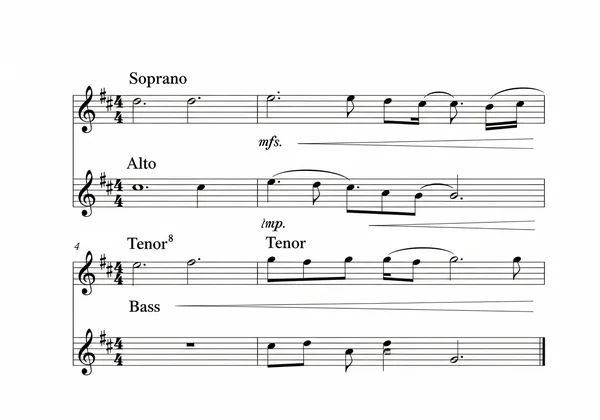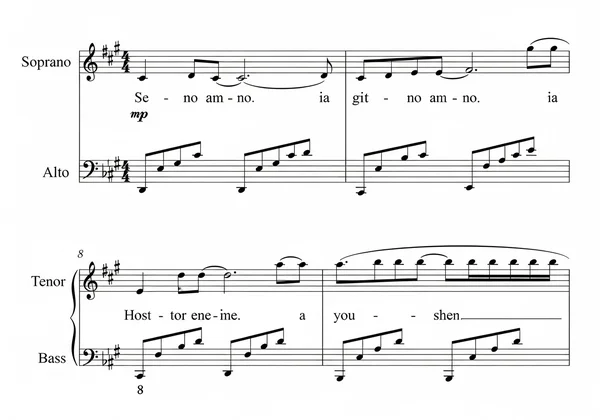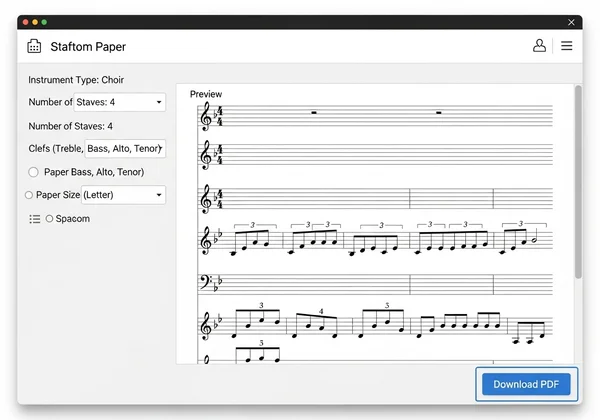कोरल स्टाफ पेपर और खाली शीट संगीत: गायकों के लिए मुखर नोटेशन में निपुणता
कोरस के लिए रचना या व्यवस्था करना अत्यंत संतोषजनक है, लेकिन इसमें अपनी चुनौतियाँ भी हैं। जटिल क्लेफ़ को समझने से लेकर कई मुखर भागों को कलात्मक रूप से व्यवस्थित करने तक, रचनाकारों, संगीत शिक्षकों और छात्रों को अक्सर कोरस के लिए लिखने में विशिष्ट बाधाओं का सामना करना पड़ता है। मुखर एन्सेम्बल्स के लिए विशेष रूप से डिज़ाइन किया गया निःशुल्क स्टाफ पेपर मुझे कहाँ मिल सकता है? यह व्यापक मार्गदर्शिका आपको मुखर नोटेशन की मूल बातें समझने में मदद करेगी और यह बताएगी कि हमारा प्लेटफ़ॉर्म आपकी सभी कोरल नोटेशन आवश्यकताओं के लिए एक आदर्श, अनुकूलन योग्य आधार कैसे प्रदान करता है, जो आपकी संगीत रचनात्मकता को सशक्त बनाता है।
आवश्यक मुखर नोटेशन को समझना
प्रभावी कोरल लेखन के लिए मुखर नोटेशन की मूल बातों की ठोस समझ आवश्यक है। एकल वाद्य संगीत के विपरीत, मुखर के लिए लेखन में व्यक्तिगत मुखर रेंज, मिश्रण और पाठ्य स्पष्टता पर सावधानीपूर्वक विचार करने की आवश्यकता होती है। चाहे आप एक अनुभवी रचनाकार हों या एक उभरते हुए संगीत छात्र, स्पष्ट, पेशेवर और प्रदर्शन योग्य कोरल स्कोर बनाने के लिए इन मूल बातों में निपुणता प्राप्त करना महत्वपूर्ण है।
कोरस के लिए सामान्य क्लेफ़ और मुखर रेंज
जब आप अपना कोरल स्टाफ पेपर तैयार करना शुरू करते हैं, तो पहली बातों में से एक प्रत्येक मुखर भाग के लिए उपयुक्त क्लेफ़ का चयन करना है। कोरल संगीत मुख्य रूप से ट्रेबल और बास क्लेफ़ का उपयोग करता है, जिसे अक्सर ऑल्टो और टेनर क्लेफ़ द्वारा पूरक किया जाता है, विशेष रूप से पुराने स्कोर या विशिष्ट व्यवस्थाओं में। सोप्रानो, ऑल्टो, टेनर और बास (SATB) के लिए विशिष्ट मुखर रेंज को समझना मौलिक है। सोप्रानो आम तौर पर ट्रेबल क्लेफ़ का उपयोग करते हैं, ऑल्टो ट्रेबल या ऑल्टो क्लेफ़ का उपयोग कर सकते हैं, टेनर आम तौर पर ट्रेबल क्लेफ़ का उपयोग करते हैं जिसके नीचे "8" अंकित होता है (जो लिखे जाने वाले से एक ऑक्टेव नीचे गाया जाता है), या कभी-कभी टेनर क्लेफ़ का। बास बास क्लेफ़ का उपयोग करते हैं। सही क्लेफ़ का चयन सुनिश्चित करता है कि आपका हस्तलिखित पत्र इच्छित पिचों को सटीक रूप से दर्शाता है। हमारा प्लेटफ़ॉर्म सटीक मुखर आवश्यकताओं के अनुरूप आपके खाली शीट संगीत को अनुकूलित करने के लिए विभिन्न क्लेफ़ विकल्प प्रदान करता है।

कोरल व्यवस्थाओं के लिए सही स्टाफ पेपर लेआउट चुनना
आपके स्टाफ पेपर का लेआउट आपके कोरल स्कोर की स्पष्टता और पठनीयता में महत्वपूर्ण भूमिका निभाता है। अधिकांश कोरल व्यवस्थाओं के लिए, आप एक ऐसी प्रणाली चाहेंगे जो मुखर भागों को स्पष्ट रूप से अलग करे और आसान दृश्य ट्रैकिंग की अनुमति दे। इसमें अक्सर प्रति सिस्टम कई स्टाफ़ होते हैं - आमतौर पर SATB के लिए दो (एक सोप्रानो/ऑल्टो के लिए, एक टेनर/बास के लिए) या चार व्यक्तिगत स्टाफ़ शामिल होते हैं। कोरस स्टाफ पेपर पर रेखाओं की संख्या भिन्न हो सकती है, लेकिन मानक पाँच-रेखा वाले स्टाफ़ सार्वभौमिक हैं। अक्षरों (lyrics), डायनामिक्स और अन्य चिह्नों के लिए पर्याप्त जगह देने के लिए स्टाफ़ के बीच रिक्ति पर विचार करें। हमारा प्लेटफ़ॉर्म इस विकल्प को सरल बनाता है, जिससे आप आदर्श कोरल व्यवस्था के लिए अपने प्रिंट करने योग्य स्टाफ पेपर लेआउट को अनुकूलित कर सकते हैं। अपना कस्टम कोरस स्टाफ पेपर लेआउट बनाने के लिए पर जाएँ।
कोरस के लिए प्रभावी ढंग से लिखने की तकनीकें
क्लेफ़ और रेंज की मूल बातों से परे, कोरस के लिए प्रभावी ढंग से लिखने में विशिष्ट तकनीकें शामिल हैं जो यह सुनिश्चित करती हैं कि आपका स्कोर न केवल संगीत की दृष्टि से सुदृढ़ है, बल्कि गायकों के लिए व्यावहारिक भी है। विचारशील नोटेशन इस बात पर महत्वपूर्ण प्रभाव डालता है कि कोरस आपके संगीत की व्याख्या कितनी आसानी से और सटीकता से कर सकता है।
SATB वाइसिंग्स को स्पष्ट और सटीक रूप से नोट करना
मानक SATB (सोप्रानो, ऑल्टो, टेनर, बास) चार-भाग सामंजस्य कोरल संगीत का आधार स्तंभ है। SATB वाइसिंग्स को नोट करते समय, स्पष्टता आवश्यक है। सोप्रानो और टेनर आवाजें आम तौर पर ऊपर की ओर डंठल वाली रेखा साझा करती हैं, जबकि ऑल्टो और बास आवाजें एक ही स्टाफ़ पर नीचे की ओर डंठल वाली रेखा साझा करती हैं, या अधिकतम स्पष्टता के लिए प्रत्येक का अपना स्टाफ़ हो सकता है। व्यक्तिगत मुखर भागों को आसानी से पहचानने योग्य बनाने के लिए उचित डंठल दिशा, बीमिंग और नोटों की रिक्ति महत्वपूर्ण है। स्टाफ नोटेशन पेपर के प्रति इस सूक्ष्म दृष्टिकोण से रिहर्सल सुव्यवस्थित होंगी और प्रदर्शन बेहतर होगा।

अपने मुखर स्कोर में बोलों और पाठ को एकीकृत करना
मुखर नोटेशन का एक अनूठा पहलू बोलों और पाठ का एकीकरण है। पाठ को उन नोटों के नीचे स्पष्ट रूप से रखा जाना चाहिए जिनसे वे संबंधित हैं, और बोलों को उनकी संबंधित पिचों के साथ सटीक रूप से संरेखित किया जाना चाहिए। मेलिस्मास (एक बोल जिसे कई नोटों पर गाया जाता है) और शब्द एक्सटेंशन (स्थायी बोलों के लिए हाइफ़न) का सटीक रूप से उपयोग करें। गायक के लिए पठनीयता सुनिश्चित करने के लिए फ़ॉन्ट आकार और स्पष्टता पर विचार करें, विशेषकर जब कई छंदों या विदेशी भाषाओं से निपटना हो। हमारे खाली शीट संगीत टेम्पलेट बोलों के लिए पर्याप्त जगह प्रदान करते हैं, जिससे यह प्रक्रिया सहज हो जाती है।
डायनामिक्स, आर्टिक्यूलेशन और प्रदर्शन नोट्स जोड़ना
अपनी कोरल रचना को जीवंत बनाने के लिए, आपको संगीत निर्देशों की एक पूरी श्रृंखला शामिल करनी होगी। डायनामिक्स (जैसे p, f, cresc.) स्वरमान में परिवर्तन का संकेत देते हैं, जबकि आर्टिक्यूलेशन (जैसे स्टाकाटो, लेगेटो, एक्सेंट) यह मार्गदर्शन करते हैं कि नोट कैसे गाए जाते हैं। इसके अतिरिक्त, प्रदर्शन नोट्स (जैसे, टेम्पो अंकन, esप्रेसिवो या सॉस्टेनटो जैसे अभिव्यंजक निर्देश) कोरस और कंडक्टर के लिए महत्वपूर्ण संदर्भ प्रदान करते हैं। इन तत्वों को आपके हस्तलिखित पत्र पर स्पष्ट रूप से रखा जाना चाहिए, अक्सर स्टाफ़ के ऊपर या नीचे, यह सुनिश्चित करते हुए कि आपके संगीत के दृष्टिकोण की हर सूक्ष्मता संप्रेषित हो।
अपना मुफ्त, प्रिंट करने योग्य कोरस स्टाफ पेपर प्राप्त करें
उपयुक्त खाली संगीत स्टाफ पेपर की खोज उन लोगों के लिए एक नियमित चुनौती हो सकती है जो कोरल संगीत में शामिल हैं। चाहे आप असाइनमेंट तैयार कर रहे शिक्षक हों, नए विचारों को स्केच कर रहे रचनाकार हों, या नोटेशन का अभ्यास कर रहे छात्र हों, उच्च-गुणवत्ता वाले, अनुकूलन योग्य पेपर तक तत्काल पहुँच अमूल्य है। हमारी वेबसाइट ठीक उसी के लिए आपका समर्पित संसाधन है।
हमारा ऑनलाइन टूल कस्टम कोरस स्टाफ पेपर निर्माण को कैसे सरल बनाता है
हमारा ऑनलाइन टूल कोरल स्टाफ पेपर खोजने या खरीदने की परेशानी को दूर करने के लिए डिज़ाइन किया गया है। हम एक पूरी तरह से निःशुल्क, अत्यधिक अनुकूलन योग्य ऑनलाइन टूल प्रदान करते हैं जो आपकी विशिष्ट आवश्यकताओं के अनुरूप पेशेवर स्टाफ पेपर पीडीएफ फाइलें उत्पन्न करता है। बस हमारी वेबसाइट पर जाएं, उपकरण प्रकारों में से "कोरस" का चयन करें, और फिर प्रति सिस्टम स्टाफ़ की अपनी वांछित संख्या, क्लेफ़ और यहां तक कि पेपर आकार (लेटर या A4) चुनें। हमारा सहज इंटरफ़ेस आपको डाउनलोड करने से पहले अपनी सेटिंग्स को ठीक करने की अनुमति देते हुए एक तत्काल पूर्वावलोकन प्रदान करता है। इसका मतलब है कि आप किसी भी कोरल परियोजना के लिए शीघ्रता से निःशुल्क स्टाफ पेपर उत्पन्न कर सकते हैं। हमारे निःशुल्क स्टाफ पेपर जनरेटर पर जाकर अपनी आवश्यकताओं के अनुरूप प्रिंट करने योग्य स्टाफ पेपर डिज़ाइन करें।

अपने कोरल स्कोर को प्रिंट करने और व्यवस्थित करने के लिए सुझाव
एक बार जब आप हमारी वेबसाइट से अपना कोरल स्टाफ पेपर पीडीएफ उत्पन्न और डाउनलोड कर लेते हैं, तो अगला कदम इसे प्रिंट करना और व्यवस्थित करना है। सर्वोत्तम परिणामों के लिए, मानक प्रिंटर पेपर या थोड़ी भारी गुणवत्ता वाले कागज का उपयोग करें यदि आप अधिक टिकाऊ अनुभव पसंद करते हैं। स्पष्ट, कुरकुरी रेखाएँ प्राप्त करने के लिए अपनी प्रिंटर सेटिंग्स को उच्च-गुणवत्ता वाले आउटपुट के लिए अनुकूलित करना सुनिश्चित करें। बड़े प्रोजेक्ट्स पर काम करते समय, अपने स्कोर को व्यवस्थित रखने के लिए तीन-छेद वाले पंच और बाइंडर का उपयोग करने पर विचार करें। प्रत्येक अनुभाग या मुखर भाग को लेबल करना भी अत्यंत सहायक हो सकता है। अपने खाली शीट संगीत को साफ-सुथरा प्रिंट और व्यवस्थित रखने से न केवल लिखने में सहायता मिलती है, बल्कि यह प्रदर्शन या साझा करने के लिए आपके स्कोर को तैयार भी करता है।
हमारे मुफ्त स्टाफ पेपर टूल से अपनी कोरल रचनाओं को सशक्त बनाएं
कोरल संगीत की दुनिया अभिव्यंजक संभावनाओं से समृद्ध है, और सही उपकरण आपको अपने मुखर विचारों को जीवंत करने के लिए सशक्त बनाते हैं। संगीत छात्रों के लिए सरल अभ्यासों से लेकर रचनाकारों के लिए जटिल व्यवस्थाओं तक, और संगीत शिक्षकों के लिए अमूल्य शिक्षण सहायता तक, उच्च-गुणवत्ता वाला कोरल स्टाफ पेपर एक अनिवार्य संसाधन है। StaffPaper.org पर, हम आपके लिए वह संसाधन बनने के लिए समर्पित हैं, जो आपकी संगीत यात्रा के हर कदम का समर्थन करने के लिए निःशुल्क, अनुकूलन योग्य और तुरंत डाउनलोड करने योग्य खाली स्टाफ पेपर प्रदान करते हैं।
उपयुक्त हस्तलिखित पत्र की कमी को अपने रचनात्मक प्रवाह में बाधा न डालने दें। अपनी संगीत दृष्टि को ठोस स्कोर में बदलने में मदद करने के लिए, हमारी वेबसाइट की सरलता और दक्षता का लाभ उठाएं ताकि आपको आवश्यक निःशुल्क कोरल शीट संगीत ठीक उसी समय मिल सके।
अपने कोरल विचारों को जीवंत करने के लिए तैयार हैं? आज ही StaffPaper.org पर जाएं और अपना आदर्श कोरल स्टाफ पेपर बनाएं!

कोरस स्टाफ पेपर और मुखर नोटेशन के बारे में अक्सर पूछे जाने वाले प्रश्न
कोरस के लिए स्टाफ पेपर पर कितनी लाइनें होती हैं?
कोरल के लिए मानक स्टाफ पेपर, अधिकांश संगीत नोटेशन की तरह, एक स्टाफ बनाने वाली पाँच समानांतर क्षैतिज रेखाएँ प्रदर्शित करता है। कोरस के लिए लिखते समय, आप आम तौर पर एक प्रणाली बनाने के लिए एक साथ समूहित कई स्टाफ़ देखेंगे, जो सोप्रानो, ऑल्टो, टेनर और बास आवाजों को समायोजित करता है। हमारा प्लेटफ़ॉर्म आपको अपनी कोरल व्यवस्था आवश्यकताओं के अनुरूप, प्रति सिस्टम स्टाफ़ की विभिन्न संख्या वाले लेआउट चुनने की अनुमति देता है।
मुखर शीट संगीत लिखने के लिए सबसे अच्छा पेपर कौन सा है?
मुखर शीट संगीत लिखने के लिए सबसे अच्छा पेपर आम तौर पर रोजमर्रा के उपयोग के लिए मानक 20 lb बॉन्ड पेपर होता है, या यदि आप अधिक टिकाऊ अनुभव पसंद करते हैं या ऐसी स्याही का उपयोग करने का इरादा रखते हैं जो पतले कागज से रिस सकती है तो थोड़ी भारी गुणवत्ता वाला कागज (जैसे 24 lb या 28 lb) होता है। मुख्य बात यह है कि एक चिकनी सतह हो जो पेंसिल या स्याही को बिना धब्बा लगाए अच्छी तरह से स्वीकार करे। हमारी कोरल स्टाफ पेपर पीडीएफ फाइलें लेटर या A4 जैसे मानक पेपर आकारों पर उच्च-गुणवत्ता वाले मुद्रण के लिए डिज़ाइन की गई हैं, जिससे आपको आवश्यक प्रिंट करने योग्य स्टाफ पेपर प्राप्त करना आसान हो जाता है।
मुझे ऑनलाइन मुफ्त कोरस स्टाफ पेपर कहाँ मिल सकता है?
आप आसानी से हमारी वेबसाइट पर ऑनलाइन निःशुल्क कोरल स्टाफ पेपर प्राप्त कर सकते हैं। हमारी वेबसाइट कोरल नोटेशन के लिए विशेष रूप से डिज़ाइन की गई स्टाफ पेपर पीडीएफ फ़ाइलों को उत्पन्न और डाउनलोड करने के लिए एक उपयोगकर्ता-अनुकूल, अत्यधिक अनुकूलन योग्य टूल प्रदान करती है। आप स्टाफ़ की संख्या, क्लेफ़ और पेपर आकार का चयन कर सकते हैं, फिर बिना किसी पंजीकरण या लागत के अपने कस्टम निःशुल्क स्टाफ पेपर को तुरंत डाउनलोड कर सकते हैं। विकल्पों का पता लगाने के लिए हमारी वेबसाइट पर जाएँ।
कोरल नोटेशन और एकल मुखर नोटेशन के बीच क्या अंतर है?
जबकि दोनों में मुखर नोटेशन शामिल है, कोरल नोटेशन में आम तौर पर एक साथ कई आवाजों (जैसे, SATB) के लिए लेखन शामिल होता है, अक्सर साझा स्टाफ़ पर, सामंजस्य, भागों के बीच मुखर नेतृत्व और समग्र पहनावा ध्वनि पर ध्यान केंद्रित किया जाता है। दूसरी ओर, एकल मुखर नोटेशन, एक एकल आवाज पर केंद्रित होता है, जिसमें अक्सर वाद्य संगत के साथ मेलोडी, व्यक्तिगत वाक्यांश और विशिष्ट व्याख्यात्मक बारीकियों पर जोर दिया जाता है। हमारे विविध खाली शीट संगीत विकल्प दोनों का समर्थन कर सकते हैं, जिसमें समर्पित कोरल स्टाफ पेपर टेम्पलेट शामिल हैं।
क्या मैं कोरल व्यवस्थाओं के लिए मानक स्टाफ पेपर का उपयोग कर सकता हूँ?
हालांकि आप तकनीकी रूप से कोरल व्यवस्थाओं के लिए मानक स्टाफ पेपर का उपयोग कर सकते हैं, विशेष कोरल स्टाफ पेपर (जैसे कि हमारे प्लेटफ़ॉर्म पर उपलब्ध है) कहीं अधिक कुशल और स्पष्ट है। मानक पेपर में प्रति सिस्टम पर्याप्त स्टाफ़ या कई मुखर भागों और बोलों के लिए आदर्श रिक्ति नहीं हो सकती है। समर्पित कोरल स्टाफ पेपर में अक्सर पूर्व-समूहित स्टाफ़ होते हैं, जिससे कोरल के लिए लिखना बहुत आसान हो जाता है और अधिक पेशेवर दिखने वाला स्कोर तैयार होता है।